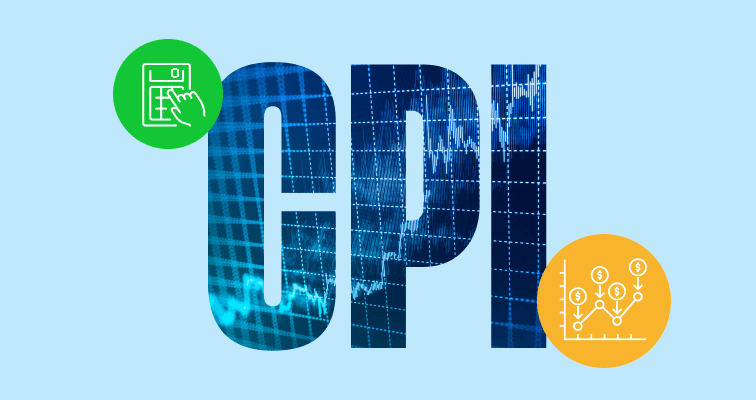Interested in learning more about the Consumer Price Index (CPI)? Find out what the CPI is, how it is calculated, its applications and some of its limitations.
To be a potentially successful investor, you don’t need to know every complex financial term, use dozens of performance charts and strictly follow all the advice from successful traders — although it may help! Many traders, particularly retail investors, get along just fine by choosing their ideal investment platform, doing their own research and then building their portfolio.
This being said, some terms are important to know — not just for investment purposes, but for your wider financial literacy. The Consumer Price Index — or CPI — is one such term. When you understand how the CPI works and why it is so important, you will be better placed to determine why things cost what they do, and what the inflation outlook looks like for the economy.

What is the Consumer Price Index (CPI)?
The Consumer Price Index (CPI) is the measure of the aggregate price level in a specific economy — it is the reason why different countries have their own CPI, as buying habits and costs differ.
Essentially, the CPI looks at a “fixed basket” of goods and services that citizens are commonly buying at any one time. The CPI not only measures the price of this “basket,” but also the rise and fall of the purchasing power of a country’s currency.
“Depending on the country, CPI calculations are generally made every quarter. Here are some of the “fixed” goods and services that typically fall into a CPI market basket.”
Similar to the CPI, core inflation (or “Core CPI”) measures the price of a basket of goods, but removes volatile prices, such as food and energy, to create a more stable measure of inflation trends.
What does the CPI measure?
The CPI measures a variety of items, depending on the country. These are often grouped according to food and drink, housing, transportation, education, etc., but may also include miscellaneous items, such as haircuts, tobacco and even funeral costs. For most parts of the world, it is released monthly (as m/m and y/y figures).
What is the CPI used for?
The main purpose of the CPI is to measure inflation. It achieves this by tracking the change in the price of the commonly purchased goods and services described above.
Why is the CPI important?
Using the CPI to measure the price of consumer goods can provide a range of insights regarding inflation and more. Importantly, political leaders and financial policymakers can use the information provided by the CPI to support macroeconomic policy decisions. This may include the country’s Federal Reserve raising or lowering the national interest rate, for example.
How does the CPI affect the stock market?
While data from the CPI usually does not have a direct influence on the stock market, the information it collects can have a broader impact on markets. This is because if the CPI monitors a significant rise in inflation, this will generally make the stock market more volatile. Also, if interest rates rise, it may mean that business activity slows, which can affect a number of stocks.

How is the CPI calculated?
To determine the Consumer Price Index, the following calculation is used:
Cost of the market basket in a given year / cost of the market basket in the base year X 100 = CPI
Depending on the country, CPI calculations are generally made every quarter. Here are some of the “fixed” goods and services that typically fall into a CPI market basket:

Food and beverages

Housing

Clothing apparel

Transportation

Recreation activities

Medical care
The CPI and inflation: what is the connection?
When measured by the Consumer Price Index, inflation is simply the rise in the cost of market basket items — that is, the fixed goods and services that are purchased by specific household groups.
In general, central banks aim for an annual inflation rate of 2%, to keep price rises low, stable and predictable.
Using the CPI is the most popular way to measure both inflation and deflation. This is because monitoring everyday purchases is the easiest way to determine whether prices are going up or down.
Policymakers are attracted to CPI data because it can help to inform their decision-making. It can also have an influence on the financial markets, business activities and consumer buying habits.
Tip: If sales fall, stock prices may follow.
When inflation is high, most people’s everyday costs increase, leaving less disposable income for discretionary and luxury purchases. If fewer people are spending on entertainment and non-essential goods, then companies that rely on this type of spending, such as the Walt Disney Company, Nike and Netflix, may be negatively affected.
What are the limitations of the CPI?
The CPI is not a perfect measurement tool. While it is a broadly useful tool to influence policymaking and indicate inflation and deflation, it does have some limitations.
Indeed, the concept’s relevance falls short for those who live in rural and regional areas, as most countries don’t take the spending habits of these citizens into account.

One significant limitation is substitution bias, which happens because not all prices change proportionately.
So, say a specific product in the fixed market basket has increased in price; the average consumer may be turning to cheaper alternatives. Subsequently, the inclusion of the more expensive goods in the CPI calculation is no longer relevant for many consumers, because they are saving money on an alternative, and the CPI may no longer be accurate.
The biggest limitation, however, is in individual relevance. Because every consumer is different, the spending habits of the individual often don’t reflect the average consumer. In many cases, consumers will experience a disproportionate increase in the level of inflation compared to the CPI, while others may have no experience with inflation at all.
Tip: Set financial goals and research different types of stocks before you buy to help mitigate risk.
Final Thoughts
While the CPI does not explicitly influence the stock market, the information it gathers can have an effect on the financial markets, business activity and consumer spending habits. As part of your regular investment research, it is worth looking at the CPI from time to time to understand how it might be having an impact — however large or small — on the broader stock market.
Use the eToro Academy to learn more about investing.
FAQs
- Is high CPI good or bad?
-
A rising CPI reflects rising consumer prices, and, thus, higher levels of inflation. While this may mean the economy is thriving, if the CPI grows year-to-year, it can also be negative, as it usually indicates that the cost of living is increasing. If wages are not growing in tandem, it can put the average citizen in a worse financial position.
- Does CPI include food and fuel?
-
In most cases, yes. While every country has a different “market basket” used to calculate its Consumer Price Index, especially in Western nations, both food (including beverages) and automotive fuel are included in the CPI. In Australia, for example, 2022’s CPI basket featured 11% transport and 17% food and non-alcoholic beverages.
- What does a low CPI mean?
-
A low CPI could indicate that the economy is contracting, with lower levels of inflation or even deflation. While it may mean cheaper goods and services in the short term, it could have longer-term negative implications if the economy does not turn around.
This information is for educational purposes only and should not be taken as investment advice, personal recommendation, or an offer of, or solicitation to, buy or sell any financial instruments.
This material has been prepared without regard to any particular investment objectives or financial situation and has not been prepared in accordance with the legal and regulatory requirements to promote independent research. Not all of the financial instruments and services referred to are offered by eToro and any references to past performance of a financial instrument, index, or a packaged investment product are not, and should not be taken as, a reliable indicator of future results.
eToro makes no representation and assumes no liability as to the accuracy or completeness of the content of this guide. Make sure you understand the risks involved in trading before committing any capital. Never risk more than you are prepared to lose.

